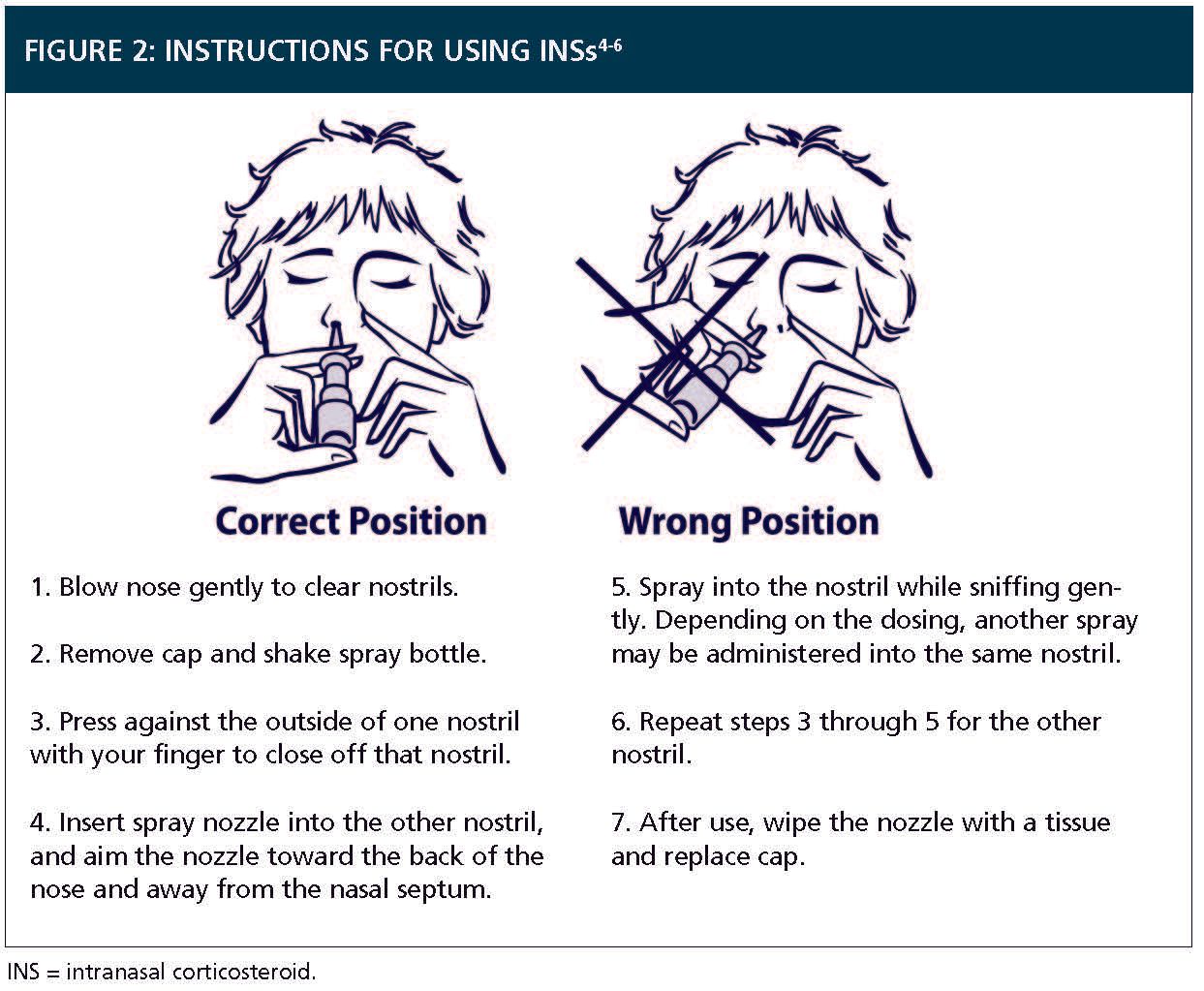Publication
Article
Pharmacy Times
Practical Aspects of OTC Intranasal Corticosteroid Use: Important Educational Points to Share with Patients
This article was sponsored by Chattem, Inc.
Intranasal corticosteroids (INSs) make up the most effective class of medication for controlling nasal symptoms of allergic rhinitis (AR).1 To achieve their optimal benefits, however, it is important that patients use INSs correctly and consistently. This article describes the practical aspects of OTC INS use, including priming of the spray bottle and proper administration technique, to help pharmacists educate their patients. Information on formulation characteristics is also included, as these characteristics may affect patient experience with INSs. By assisting patients with product selection and providing instructions regarding the proper use of INSs, pharmacists can help patients achieve the best possible outcomes.
INS Nasal Sprays: Instructions for Use
Two INS products are now available over the counter for the relief of nasal symptoms of AR: Nasacort Allergy 24HR (triamcinolone acetonide) and Flonase Allergy Relief (fluticasone propionate). Both products are indicated for use in adults and children (Nasacort in patients 2 years and older, Flonase in patients 4 years and older). The use of INSs by younger patients should be supervised by an adult.2,3
The instructions for use of the 2 OTC INSs are similar: before the first use, patients need to prime the spray bottle (Figure 1).4,5 To do so, advise patients to shake the bottle well and to press and release the nozzle, away from the face, until a fine mist is produced. The spray bottle should be re-primed if it has not been used for some time (2 weeks or longer for Nasacort, 1 week or longer for Flonase).4,5

To use the INS spray, patients should first gently blow their nose to clear the nostrils (Figure 2).4-6 Instruct them to remove the cap and shake the spray bottle, then to close off one nostril by pressing against the outside of that nostril with their finger. It is important for them to know to administer the spray away toward the back of the nose and away from the nasal septum, as spraying INSs directly on the nasal septum may increase the likelihood of experiencing epistaxis.4-6 While sniffing gently, patients should press down on the spray nozzle to administer 1 spray. Depending on the dosing, another spray may be administered into the same nostril. Patients should then repeat this procedure with the second nostril. To help prevent dripping into the back of the throat, direct patients not to tilt their head back.6 After use, patients should wipe the nozzle with a clean tissue and replace the cap.4-6

At times, patients may seek advice on cleaning a blocked INS spray bottle. Instruct them to remove the cover, pull off the spray nozzle, soak the nozzle in warm water for a few minutes, rinse the nozzle with cold water, and allow the pump to air dry before replacing the spray nozzle. Patients should not try to unblock the nozzle with a pin or sharp object because doing so can damage the nozzle, resulting in inaccurate dosing.4,7
Patient Experience
Dosing
Dosing varies by product. For Nasacort, adults and adolescents should start treatment with 2 sprays into each nostril once daily. After allergy symptoms improve, this may be reduced to 1 spray into each nostril once daily.2
For Flonase, adults and adolescents should start treatment with 2 sprays into each nostril once daily. After the first week, this may be reduced to 1 spray into each nostril once daily. If 1 spray into each nostril does not control symptoms, the patient should go back to 2 sprays.7
Although nasal symptoms may improve within 3 to 12 hours, optimal control may take several days of regular INS use.
1,8
Patients should be aware that INSs work best when used daily.
1
Formulation
INS product formulations differ in their characteristics, and these differences may affect the patient experience. Characteristics such as the odor and taste associated with a formulation, or the presence of alcohol in a formulation, may be important to patients.9 Nasacort was formulated specifically to be free of scent, and does not contain alcohol.2,9
Role of the Pharmacist
Symptoms of AR can be effectively relieved by OTC INS products, and pharmacists should be aware of differences in INS product formulations that may affect patient experience with a product. Pharmacists can help educate patients with AR on the appropriateness of INS therapy, the correct dosing of INS products for patients in different age groups, and practical aspects of INS use. They have an important role to play in educating patients regarding correct and consistent use of INSs to help patients achieve the best possible outcomes. By providing patients with instruction on how to prime the spray bottle and how to administer INSs, pharmacists can help patients use these products correctly to achieve optimal results.
Pharmacists should direct patients to prime the spray bottle before first use and if the spray bottle has not been used in some time (2 weeks or longer for Nasacort, 1 week or longer for Flonase).4,5 To help prevent epistaxis, pharmacists should instruct patients to spray INSs away from the septum.6 Patients should be informed that optimal relief of AR symptoms may take several days of regular INS use, and that INSs work best when used daily.1,8
References
- Wallace DV, Dykewicz MS, Bernstein DI, et al; Joint Task Force on Practice; American Academy of Allergy, Asthma & Immunology; American College of Allergy, Asthma and Immunology; Joint Council of Allergy, Asthma and Immunology. The diagnosis and management of rhinitis: an updated practice parameter. J Allergy Clin Immunol. 2008;122(suppl 2):S1-S84. doi:10.1016/j.jaci.2008.06.003.
- Nasacort Allergy 24HR drug facts. Nasacort website. http://nasacort.com/hcp/downloads/NAS_DrugFacts_FNL-4.pdf. Accessed May 5, 2015.
- Flonase Allergy Relief drug facts. Flonase website. www.flonaseprofessional.com/content/dam/NA_Pharma/Country/US/Brands/Flonase/Digital/Web/PDFs/en_us/flute-expert-site/resources/FLONASE_Drug_Facts.pdf. Accessed May 5, 2015.
- How to use. Nasacort website. http://nasacort.com/how-to-use.aspx. Accessed May 5, 2015.
- How to use. Flonase website. www.flonaseprofessional.com/content/dam/NA_Pharma/Country/US/Brands/Flonase/Digital/Web/PDFs/en_us/flute-expert-site/resources/How_To_Use_FLONASE.pdf. Accessed May 5, 2015.
- Benninger MS, Hadley JA, Osguthorpe JD, et al. Techniques of intranasal steroid use. Otolaryngol Head Neck Surg. 2004;130(1):5-24.
- How to take Flonase. Flonase website. www.flonase.com/about/how-to-use-flonase. Accessed May 5, 2015.
- Nelson HS. Mechanisms of intranasal steroids in the management of upper respiratory allergic diseases. J Allergy Clin Immunol. 1999;104(4, pt 1):S138-S143.
- Bachert C, El-Akkad T. Patient preferences and sensory comparisons of three intranasal corticosteroids for the treatment of allergic rhinitis. Ann Allergy Asthma Immunol. 2002;89(3):292-297.








